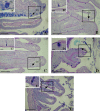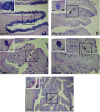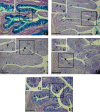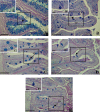Digestive Physiological Characteristics of the Gobiidae: - Characteristics of CCK-producing Cells and Mucus-secreting Goblet Cells of Stomach Fish and Stomachless Fish
- PMID: 27796002
- PMCID: PMC5078146
- DOI: 10.12717/DR.2016.20.3.207
Digestive Physiological Characteristics of the Gobiidae: - Characteristics of CCK-producing Cells and Mucus-secreting Goblet Cells of Stomach Fish and Stomachless Fish
Abstract
In this study, we investigated the characteristics of CCK-producing cells and mucus-secreting goblet cells with respect to stomach fish and stomachless fish of the Gobiidae in order to provide a basis for understanding the digestive physiology. Hairychin goby (Sagamia geneionema), which is stomachless fish, the numbers of mucus-secreting goblet cells is highest in the posterior intestine portion (P<0.05), while CCK-producing cells are scattered throughout the intestine. Gluttonous goby (Chasmichthys gulosus), which is stomach fish, mucus-secreting goblet cells are most abundant in the mid intestine portion (P<0.05), whereas CCK-producing cells are observed only in the anterior and mid intestine portion. Trident goby (Tridentiger obscurus) which is stomach fish, mucus-secreting goblet cells were most abundant in the mid intestine portion (P<0.05). CCK-producing cells are found in the anterior and mid intestine portion. Giurine goby, Rhinogobius giurinus which is also stomach fish, the largest number of mucus-secreting goblet cells showed in anterior intestine portion except for esophagus (P<0.05). CCK-producing cells are present only in the anterior and mid intestine portion. In S. geneionema, digestive action occurs in the posterior intestine portion to protect and functions to activate digestion. In contrast, in C. gulosus, T. obscurus and R. giurinus, their digestive action occurs in the anterior and mid intestine portion to protect and functions to activate digestion. Further studies of the modes of food ingestion by these fish, the contents of their digestive tracts, and the staining characteristics of the goblet cells need to be carried out.
Keywords: CCK-producing cell; Gobiidae; Mucus-secreting goblet cells; Stomach fish; Stomachless fish.
Figures









Similar articles
-
Morphology, Histology, and Histochemistry of the Digestive Tract of the Marbled Flounder Pseudopleuronectes yokohamae.Animals (Basel). 2023 Mar 5;13(5):936. doi: 10.3390/ani13050936. Animals (Basel). 2023. PMID: 36899793 Free PMC article.
-
Characterization of cholecystokinin-producing cells and mucus-secreting goblet cells in the blacktip grouper, Epinephelus fasciatus.Tissue Cell. 2013 Apr;45(2):153-7. doi: 10.1016/j.tice.2012.10.005. Epub 2012 Dec 27. Tissue Cell. 2013. PMID: 23274134
-
Morpho-histological characterisation of the alimentary canal of an important food fish, Asian seabass (Lates calcarifer).PeerJ. 2016 Aug 24;4:e2377. doi: 10.7717/peerj.2377. eCollection 2016. PeerJ. 2016. PMID: 27635341 Free PMC article.
-
Mucin-producing elements and inflammatory cells.Novartis Found Symp. 2002;248:51-68; discussion 68-75, 277-82. Novartis Found Symp. 2002. PMID: 12568488 Review.
-
Functional biology of intestinal goblet cells.Am J Physiol. 1991 Feb;260(2 Pt 1):C183-93. doi: 10.1152/ajpcell.1991.260.2.C183. Am J Physiol. 1991. PMID: 1996606 Review.
Cited by
-
Morphology, Histology, and Histochemistry of the Digestive Tract of the Marbled Flounder Pseudopleuronectes yokohamae.Animals (Basel). 2023 Mar 5;13(5):936. doi: 10.3390/ani13050936. Animals (Basel). 2023. PMID: 36899793 Free PMC article.
-
Morphological and Histological Analysis of the Gastrointestinal Systems in Triplophysa strauchii and Triplophysa tenuis: Insights into Digestive Adaptations.Animals (Basel). 2025 Apr 10;15(8):1095. doi: 10.3390/ani15081095. Animals (Basel). 2025. PMID: 40281929 Free PMC article.
-
Comparison of Circulating Markers and Mucosal Immune Parameters from Skin and Distal Intestine of Atlantic Salmon in Two Models of Acute Stress.Int J Mol Sci. 2021 Jan 21;22(3):1028. doi: 10.3390/ijms22031028. Int J Mol Sci. 2021. PMID: 33494146 Free PMC article.
-
Dietary Inclusion of Hydrolyzed Debaryomyces hansenii Yeasts Modulates Physiological Responses in Plasma and Immune Organs of Atlantic Salmon (Salmo salar) Parr Exposed to Acute Hypoxia Stress.Front Physiol. 2022 Mar 28;13:836810. doi: 10.3389/fphys.2022.836810. eCollection 2022. Front Physiol. 2022. PMID: 35418880 Free PMC article.
-
Pactacin is a novel digestive enzyme in teleosts.Sci Rep. 2021 Mar 31;11(1):7230. doi: 10.1038/s41598-021-86565-9. Sci Rep. 2021. PMID: 33790319 Free PMC article.
References
-
- Al-Hussaini AH. The feeding habits and the morphology of the alimentary tract of some teleost living in the neighbourhood of the Marine Biological Station, Ghardaqa, Red Sea. Publ Mar Biol Stn Al-Ghardaqa. 1947;5:1–61.
-
- Al-Hussaini AH. On the functional morphology of the alimentary tract of some fish in the relation to differences in their feeding habits Anatomy and histology. Q J Microsc Sci. 1949;90:109–139. - PubMed
-
- Aldman G, Grove D, Holmgren S. Duodenal acidifycation and intra-arterial injection of CCK8 increase gallbladder motility in the rainbow trout, Oncorhynchus mykiss. Gen Comp Endocrinol. 1992;86:20–25. - PubMed
-
- Aldman G, Holmgren S. Control of gall bladder motility in the rainbow trout, Salmo gairdneri. Fish Physiol Biochem. 1987;4:143–155. - PubMed
-
- Allen A, Hutton DA, Leonard AJ, Pearson JP, Sellers LA. The role of mucus in the protection of the gastroduodenal mucosa. Scand J Gastroenteral. 1986;21:71–77. - PubMed
LinkOut - more resources
Full Text Sources
Other Literature Sources

